There is no doubt that the first promotional image from LOTR on Prime is simply amazing. But what is actually going on here?
Rather than blather on with superlatives, let’s just dive on in, and take a detailed look at what it reveals.
Fair warning, though: there will be spoilers for some key elements of The Silmarillion. So, if you’ve just started reading and you have no idea what happens and avoiding story spoilers is important to you, now is the time to step away!
The Two Trees
The obvious place to begin is the trees since, as Tolkien writes in The Silmarillion, “about their fate all the tales of the Elder Days are woven”. They’re also what firmly locates this panorama in Valinor — all our conclusions derive from their presence.
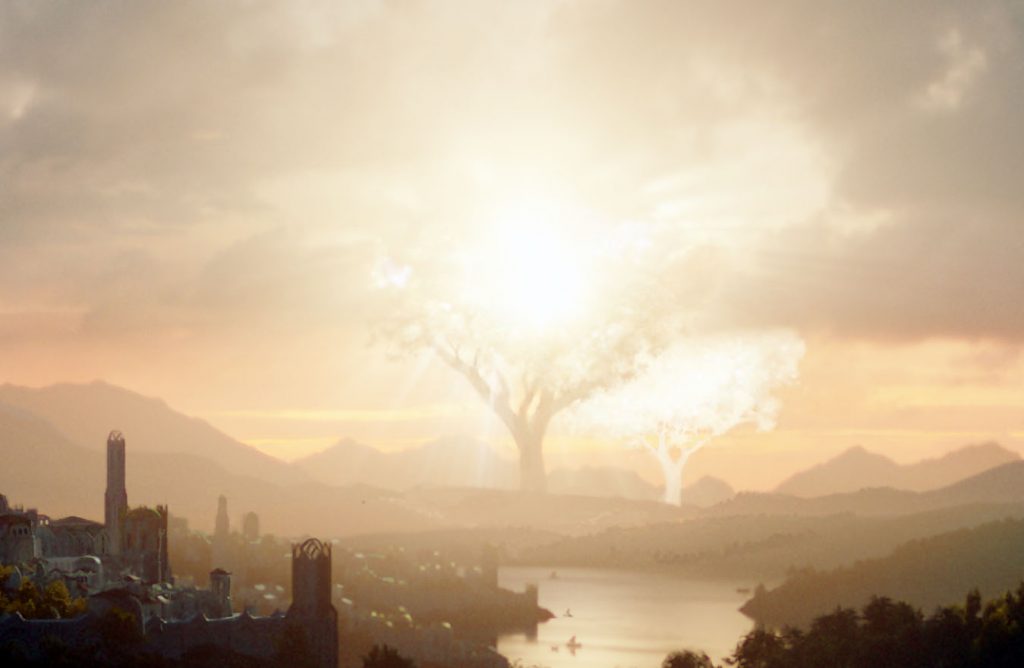
First, a description of the Two Trees of Valinor, taken from the same book.
[Telperion] had leaves of dark green that beneath were as shining silver, and from each of his countless flowers a dew of silver light was ever falling, and the earth beneath was dappled with the shadow of his fluttering leaves.
[Laurelin] bore leaves of a young green like the new-opened beech; their edges were of glittering gold. Flowers swung upon her branches in clusters of yellow flame, formed each to a glowing horn that spilled a golden rain upon the ground; and from the blossom of that tree there came forth warmth and a great light.
Of the Beginning of Days, The Silmarillion.
The trees in the LOTR on Prime panorama cannot be anything else. In the hidden city of Gondolin in Beleriand, Turgon famously created his own reproductions of the Two Trees in silver and gold. However, they emitted no light and were located within the city itself, not out on the plain. No, these are the Two Trees and that means this is Valinor.
You may wonder which tree is which.
My belief is that Laurelin — the tree of gold — is the one nearest the camera. Its shape more closely resembles that of the common beech (Fagus sylvatica). The dark trunk and boughs seem at odds with Telperion’s descritpion and the glow that emanates from it is a warm golden-yellow. And the silvery hue of the tree behind fits Tolkien’s vision of the Telperion much better.
The Two Trees: Alive? Or not?
The next key question is whether the trees are alive in this image. Is this the Years of the Trees? Or is LOTR on Prime using a clever fake-out as Professor Corey Olsen suggested may be the case on TORn Tuesday? Is the scene actually set later — long after Melkor and Ungoliant have paid their fateful visit — during the Years of the Sun, and the sun just happens to be positioned behind Laurelin?
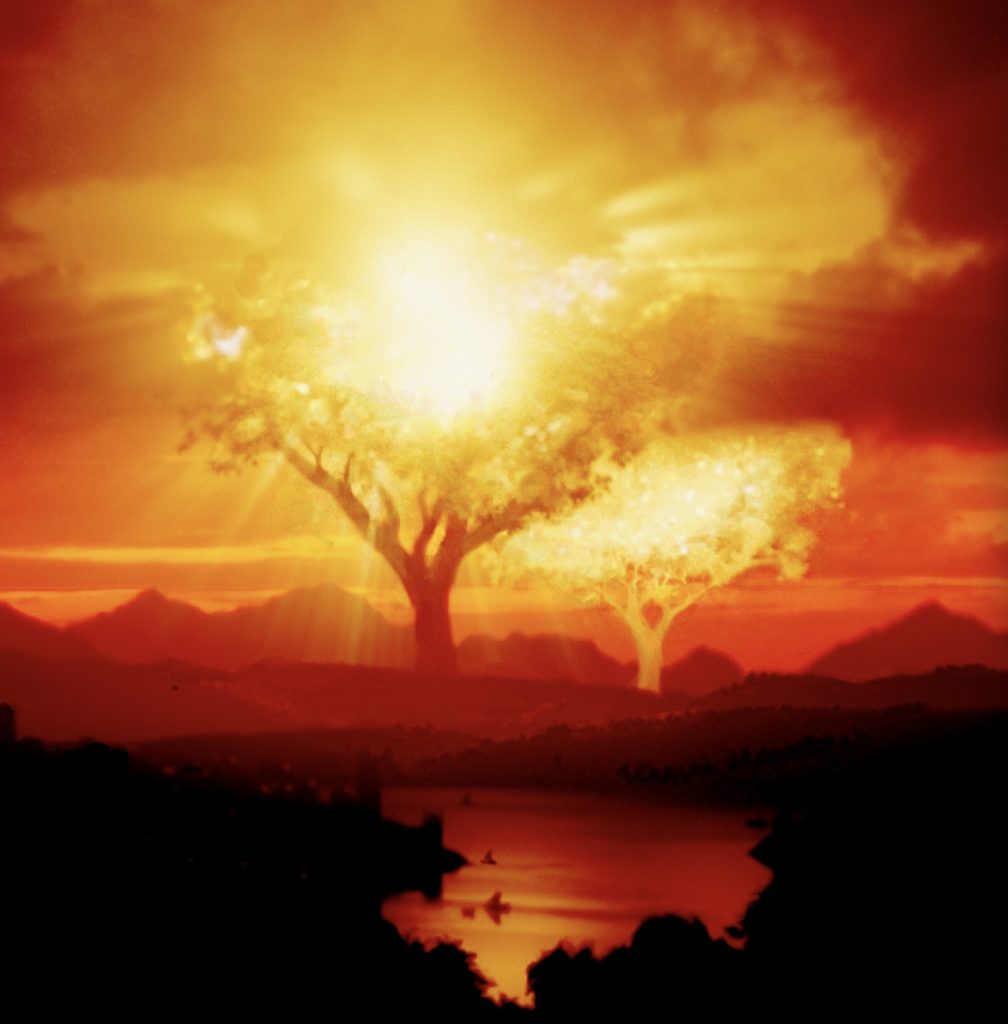
I’ve gone back and forth between the two opinions.
One the one hand, when you adjust the levels in the image and pull the brightness down, the light out of (or through) Laurelin dominates, while the glow emanating from Telperion is muted enough that it could simply be reflected sunlight.
We do know from The Silmarillion that the trees were preserved: “their lifeless stems stand yet in Valinor, a memorial of vanished joy.”
On the other hand, the trees do not appear lifeless stems. They are not “withered” and drained of life as The Silmarillion describes it. In fact, Telperion’s trunk positively gleams.
Nor do they seem brittle. The Silmarillion also states:
Yavanna arose and stood upon Ezellohar, the Green Mound, but it was bare now and black; and she laid her hands upon the Trees, but they were dead and dark, and each branch that she touched broke and fell lifeless at her feet.
Of the Flight of the Noldor, The Silmarillion.
Moreover, something about the way Telperion would be reflecting the sun just doesn’t seem right. The sun should be so far behind the trees that any reflection should be much more muted than shown. I’m no ray-tracing expert, though! (If you are and have a better idea, let us know.)
Nevertheless, I feel the weight of evidence leans to this showing a scene from The Years of the Trees sometime near the end of the Noontide of Valinor. Perhaps even the very end.
The city of white walls and towers
Next, there’s the city on the hill. I feel comfortable in saying that this is Tirion — the city of many white towers that the Noldorin and Vanyarin elves established together after first arriving in Valinor.
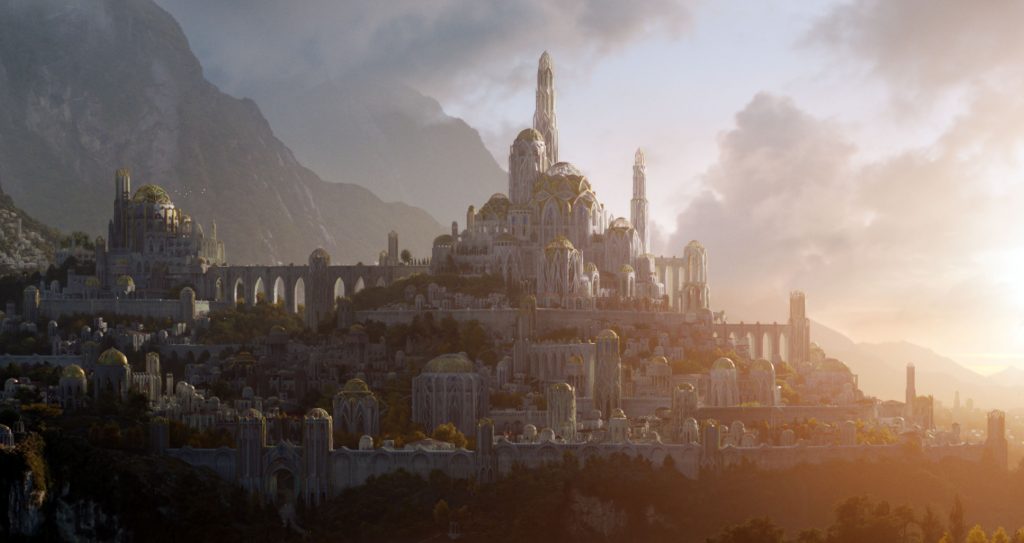
Tirion stands upon the hill of Túna at the entrance to the Calacirya (a Quenya word that translates as “The Cleft of Light”). To either side, you have the Pelóri — the immense mountain chain that walls off the interior of Aman from the rest of the world. By the time the Years of the Trees draw to a close, the Calacirya is more or less the only way through from the outside.
Conforming to that description, we see to the left and to the right in the image the slopes of steeply rising mountains. The southern side is most likely the northern shoulder of Taniquetil — the impossibly tall mountain where Manwë and Varda dwell.
However, there are some textual inconsistencies if you want to pick nits (and what are we here for if not to pick nits?).
First, there’s the city’s tall tower.
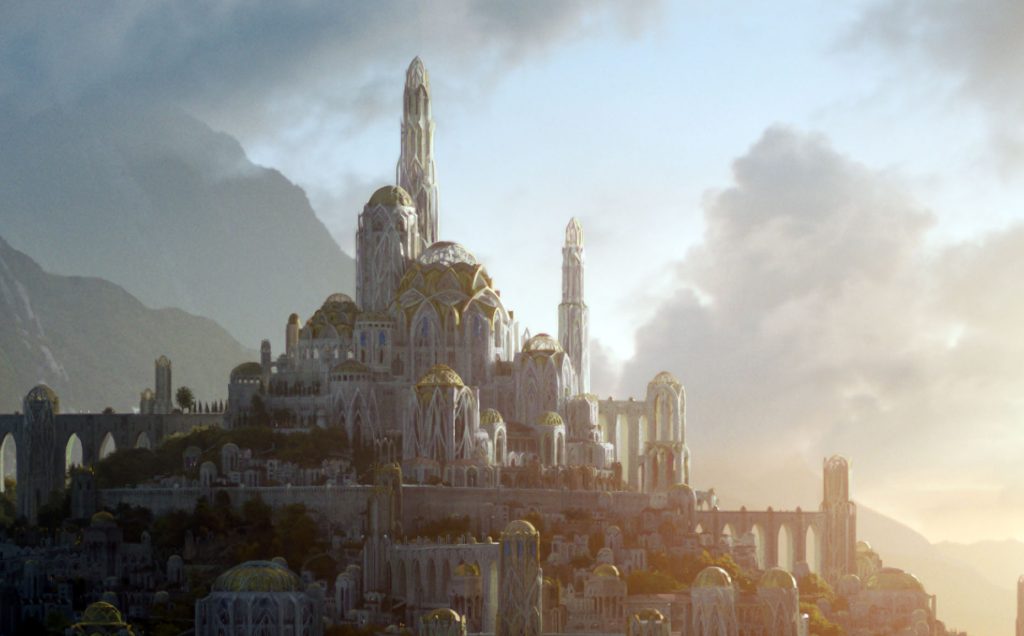
This tower is the Mindon Eldaliéva. Notably, in The Silmarillion it is reported to feature a silver lamp that was said to “shine far out into the mists of the sea”. Famously, it guides the folk of Finarfin back to the city after they turn their backs on the rebellion of Fëanor. That lamp does not seem to be shining here.
…the highest of the towers of that city was the Tower of Ingwë, Mindon Eldaliéva, whose silver lamp shone far out into the mists of the sea. Few are the ships of mortal Men that have seen its slender beam.
Of Eldamar and the Princes of the Eldalië, The Silmarillion.
Additionally, despite looking closely at the city, I see nothing that could be Tirion’s own White Tree — Galathilion.
Yavanna made for [the Noldor] a tree like to a lesser image of Telperion, save that it did not give light of its own being; Galathilion it was named in the Sindarin tongue. This tree was planted in the courts beneath the Mindon and there flourished.
Of Eldamar and the Princes of the Eldalië, the Silmarillion.
Galathilion would surely have a unique appearance compared to the other flora of the city. And it would probably draw upon similar aesthetic to Peter Jackson’s depiction of the White Tree of Gondor. Admittedly, Gondor’s White Tree is quite dead when we see it in the Return of the King.
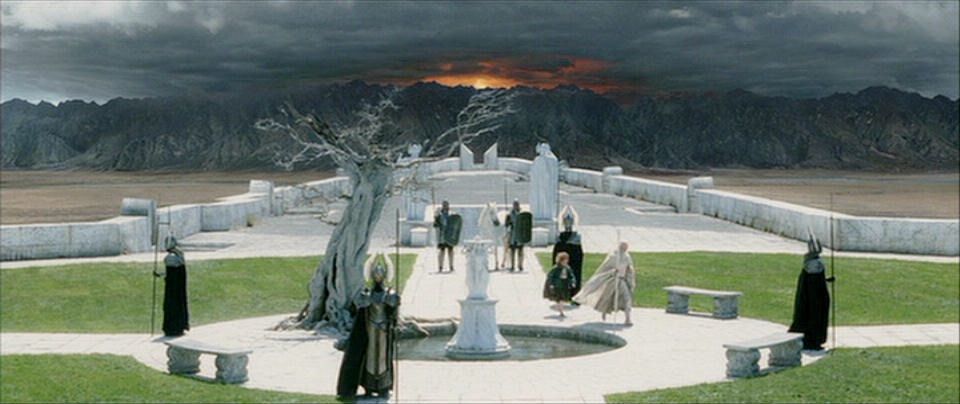
The White Tree of Tirion might also not be especially prominent. It could be, compared to the structures about it, quite small. Or its placement might be out of picture, on the far side of the hill so it receives direct light from the Two Trees.
Finally, there’s the shape and position of Túna.
The Silmarillion states that after the Valar created a gap in the Pelóri, in the “deep valley that ran down to the sea the Eldar raised a high green hill: Túna it was called.”
Should Túna be more centrally located, rather than to one side of the Calacirya? Certainly, this is how Karen Wynn Fonstad envisages it — and her sketches in The Atlas of Tolkien’s Middle-earth were made with the backing of Harper Collins and the assistance of resources like the Boedlian Library.
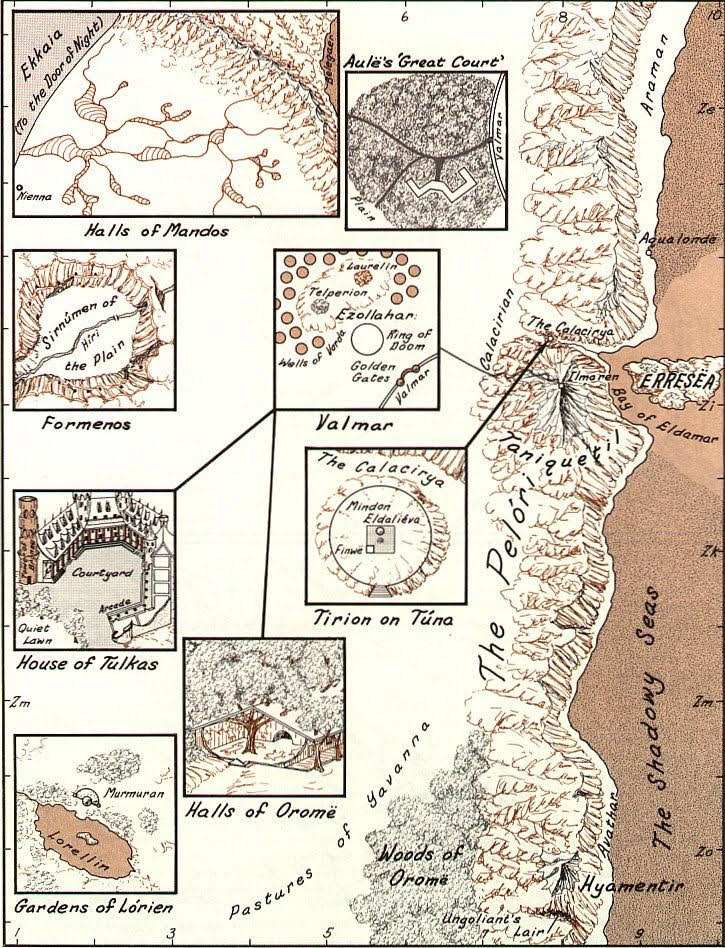
Nevertheless, the location feels more or less correct, and Wynn Fonstad’s cartography is not — as far as I know — explicitly textually supported. So the LOTR on Prime team probably can get away with playing it a little fast and loose even though they are certainly drawing on her maps.
The small river and the swan-prowed boats
Wynn Fonstad also documents one other geographical feature that is not revealed in the text of the Silmarillion — a stream or river that winds its way up the Calacirya toward Tirion. This probably explains the small river we see in the image. The question is whether it reaches all the way into the far distance. It’s hard to tell, but probably.
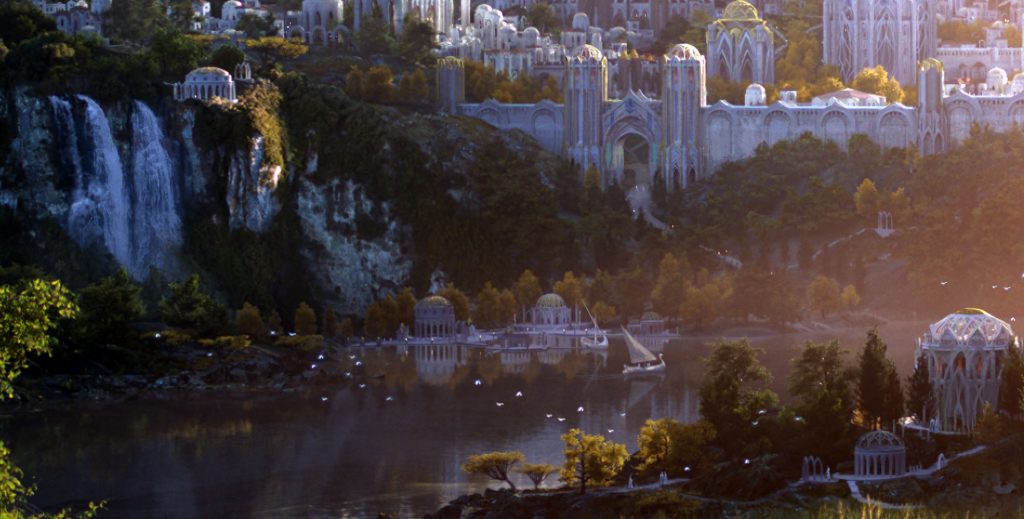
I feel that is less important than the opportunity to reveal several swan-prowed boats that we see upon the river. The question is whether these boats could be the famous White Ships of the Teleri — or smaller, but similar, pleasure craft.
The Silmarillion speaks of Alqualondë:
…the Haven of the Swans, lit with many lamps. For that was their city, and the haven of their ships; and those were made in the likeness of swans, with beaks of gold and eyes of gold and jet.
Of Eldamar and the Princes of the Eldalië, the Silmarillion.
Fëanor, of course, had those White Ships burnt after taking them by force from the Teleri in order to transport his folk to Beleriand during the Flight of the Noldor. If these are those White Ships, then this is another piece of evidence to place the image firmly within the Years of the Trees, before the destruction of Laurelin and Telperion.
The lone figure in white
Finally, we have the mysterious, lone figure in white in the foreground.
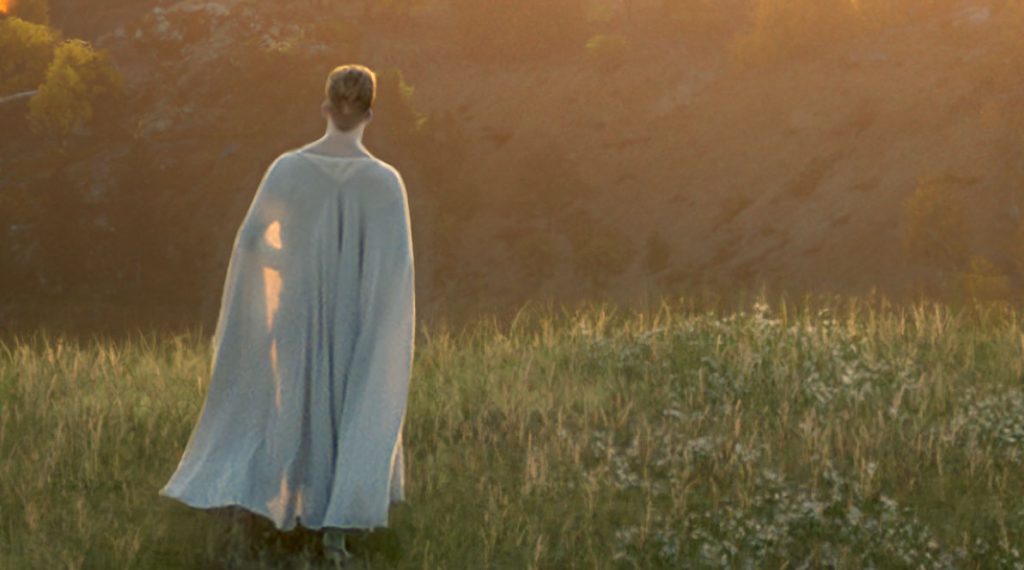
This person is blond (or blonde), has short hair (or long hair in some sort of up-do), and is attired in what is typically regarded as elvish fashion. The pose also strongly suggests that the figure is carrying a sword at the left hip.
The presence of the sword is useful, as that would definitively place the action after the release of Melkor from bondage. As The Silmarillion records, it was Melkor who “spoke to [the Noldor] concerning weapons; and in that time the Noldor began the smithying of swords and axes and spears.”
If we accept there is a sword (likely, I think), and that the Two Trees are still alive (also likely, I think) we can narrow the time period for this image.
Melkor is released from captivity in Year of the Trees (YT) 1400 according to the Annals of Aman. By YT 1450 he’s been in the ear of the Noldor sowing dissension to the point where they start making weapons — swords, axes, and shields featuring personal insignia.
But, none of the Noldor carry their weapons abroad openly for a long time after that. Not until Fëanor recklessly and publicly puts a sword at the chest of his half-brother. That might allow us to place this image to sometime after the exile of Fëanor from Tirion, but before the destruction of the trees in YT 1495.
It’s worth noting here that, according to this same timeline, Galadriel is born in YT 1362. Galadriel would be a full-grown adult. It could be her.
Might Galadriel have carried a sword in her youth? I think she might have. During the rebellion of the Noldor, The Silmarillion records that:
…Galadriel, the only woman of the Noldor to stand that day tall and valiant among the contending princes, was eager to be gone. No oaths she swore, but the words of Fëanor concerning Middle-earth had kindled in her heart, for she yearned to see the wide unguarded lands and to rule there a realm at her own will.
Of the Flight of the Noldor, The Silmarillion.
A late essay of J.R.R. Tolkien’s that Christopher Tolkien recounts in Unfinished Tales reinforces this:
She was proud, strong, and selfwilled, as were all the descendants of Finwë save Finarfin; and like her brother Finrod, of all her kin the nearest to her heart, she had dreams of far lands and dominions that might be her own to order as she would without tutelage.
The History of Galadriel and Celeborn, Unfinished Tales of Middle-earth.
The same essay also underscores Tolkien’s vision of her exceptional physique and athleticism and how she “grew to be … strong of body, mind, and will, a match for both the loremasters and the athletes of the Eldar in the days of their youth.” Plus a letter from 1973 describes the youthful Galadriel in similar fashion (while also, potentially, explaining the seemingly short-cropped hair):
[Galadriel] was [in her youth] of Amazon disposition and bound up her hair as a crown when taking part in athletic feats.
Letter #348, The Letters of J.R.R. Tolkien.
A Galadriel who in her early years of life is much more oriented to martial activities in not utterly out of Tolkien’s thinking.
Finally, there’s a treatise of Tolkien’s published in Morgoth’s Ring that outlines that while gender traditions — and individual occupational inclinations — exist among elves, these are by no means rigid, or absolute: “there are … no matters which among the Eldar only a [male elf] can think or do, or others with which only a [female elf] is concerned.”
Further, it concludes with the statement that “all … matters of labour and play, or of deeper knowledge concerning being and the life of the World, may at different times be pursued by any among the Noldor.”
If you don’t think this is possible for Galadriel, how else how do you explain Elrond’s trajectory from commander of Gil-galad’s expeditionary force to Eregion in the Second Age (and Herald of Gil-galad during the War of the Last Alliance) to renowned master of healing of the Third Age?
Other options for the figure in white
But, let’s say it’s not Galadriel. Who else might it be?
Hair colour immediately rules out most key Noldor of the time such as Finwë, Fëanor, Finrod, and Fingolfin. They are all dark-haired (as are the vast majority of Noldor). However, Galadriel’s father, Finarfin, or her grandmother, Indis, are options.
She was golden-haired, and tall, and exceedingly swift of foot. She laboured not with her hands, but sang and made music, and there was ever light and mirth about her while the bliss of Aman endured … and she walked often alone in the fields and friths of the Valar, filling them with music.
The Later Quenta Silmarillion II, The History of Middle-earth: Morgoth’s Ring.
Still, I don’t really see Indis as the sword-carrying sort. I might be wrong, but it doesn’t match my perception of her personality and her ambitions. Finarfin would, but some costumers have suggested that the outfit the figure wears is more reminiscent of Galadriel’s attire in Peter Jackson’s The Lord of the Rings.
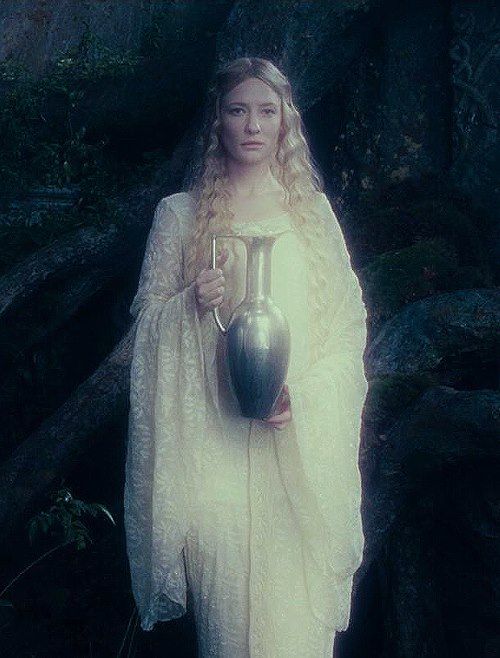
As an aside, I also like the concept of elves with short-cropped hair because it challenges an aesthetic that is ambiguously supported in canon. Would LOTR on Prime be brave enough to do that, though?
After that, we’re down to edge cases.
The radical options: Melkor or Sauron
We know that the Valar had no bodies but could assume shapes more or less at will. Morgoth’s Ring reveals that “after the coming of the Eldar they most often used shapes of ‘human’ form, though taller (not gigantic) and more magnificent”.
We don’t know Melkor’s precise form during those years before the destruction of the Two Trees. One revision (The Later Quenta Silmarillion (II)) probably made during the 1950s describes the countenance he presented to the elves as “most fair of all”. It was only after the trees had been destroyed that Melkor-as-Morgoth became fixed in the classical form we know from the Quenta Silmarillion that Chris Tolkien published in 1977 — the tall and terrifying figure clad in black armour who ever-so-reluctantly comes forth to duel Fingolfin.
However, The Silmarillion records that Melkor carried a black spear to the destruction of the Two Trees. Moreover, without any sign of his spider-shaped partner in crime, Ungoliant, there’s nothing conclusive to suggest this scene is a direct prelude to that event.
A similar shapeshifting argument applies to Sauron, who most famously assumes the fair form “Annatar” in order to win over the elven-smiths of Eregion. Sauron, of course, remained at-large in Middle-earth during the Years of the Trees, presumably busily refortifying the fortress of Angband while awaiting the return of his master.
It’s not out of the question that Sauron might have ducked across the great ocean for a bit of a peek at what was going on in Valinor with his master. Against that, such a journey is never mentioned. Still, keep in mind that Tom Shippey mentioned in an interview that LOTR on Prime has creative wiggle room as long as it doesn’t directly contradict what Tolkien himself wrote.
Why Sauron? Well, Sauron is, ultimately, the chief antagonist of this series. Alongside Galadriel, he is one of the very few consistent presences throughout Middle-earth’s history. An opening (or prologue) that directly involves Sauron may be another way for LOTR on Prime to establish the foundations of a series that is going to span a very long period of time.
The human options: Eärendil or Ar-Pharazôn the Golden
While Eärendil‘s hair colour is up for debate, he is the son of two golden-haired parents. Most art depicts him as a blonde.
But what truly interested me was the circumstances in which Eärendil arrives at Tirion: alone.
And he went up alone into the land, and came into the Calacirya, and it seemed to him empty and silent; for even as Morgoth and Ungoliant came in ages past, so now Eärendil had come at a time of festival, and wellnigh all the Elvenfolk were gone to Valimar, or were gathered in the halls of Manwë upon Taniquetil, and few were left to keep watch upon the walls of Tirion.
Of the Voyage of Eärendil and the War of Wrath, The Silmarillion.
I’ve always liked Ted Nasmith‘s illustration of this scene, and there’s something about the LOTR on Prime panorama that evokes that passage, too. The only thing that’s missing is anything that looks like the glow of a Silmaril for there those were “who saw him from afar, and the great light that he bore”. Like the Phial of Galadriel, the Silmarils emit their own light.
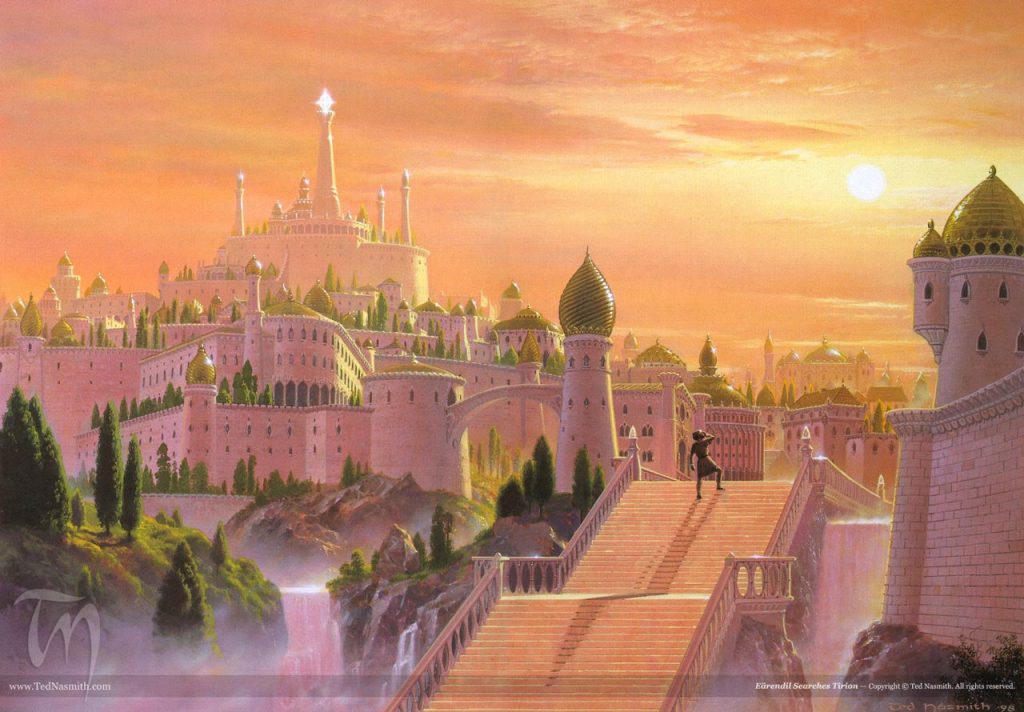
Still, as Eärendil’s arrival in Middle-earth is the beginning of the closing act of the First Age, and leads more-or-less directly to the founding of Númenor, could something like this offer a tighter link to the major story that LOTR on Prime wants to tell?
Finally — more for the sake of elimination — there’s the last king of Númenor, Ar-Pharazôn the Golden.
For Ar-Pharazôn wavered at the end, and almost he turned back. His heart misgave him when he looked upon the soundless shores and saw Taniquetil shining, whiter than snow, colder than death, silent, immutable, terrible as the shadow of the light of Ilúvatar. But pride was now his master, and at last he left his ship and strode upon the shore, claiming the land for his own, if none should do battle for it. And a host of the Númenóreans encamped in might about Túna, whence all the Eldar had fled.
AKALLABÊTH, The Silmarillion.
But. The apparel on our lone figure isn’t really ideal for battle and war. Certainly not in the fashion reminiscent of our closest visual parallel to Númenór — the Arnorian and Gondorian warriors of the War of the Last Alliance. And the figures on river do not appear alarmed in the slightest — which they would if there was a vast, approaching army of Númenóreans behind the camera.
Finally, a curveball idea: what if it actually was Galadriel finally returning home at the very end of the Third Age? To start at the very end of the story, rather than the beginning.
In conclusion
After all that, what can we conclude? We’re looking at Valinor and the Two Trees. Definitively. And, despite a few topological and architectural quirks, we’re looking west from Tirion. I’m very confident of that, too.
But are those trees alive, or dead? I just can’t tell for sure. And it’s impossible to say for certain that the figure in white is Galadriel, even though it feels the most likely option.
But, since we are here to nail our colours to the mast, I will venture the following theory: the trees are alive, the figure is Galadriel, and this is somewhere near the end of the Noontide of Valinor.
Why? Primarily because in addition to the weight of evidence it simply makes the most sense to the story for the lone figure to be Galadriel. And — regardless of which Galadriel origin story you prefer — Galadriel left Valinor before the creation of the sun and the moon. Thus the trees must be alive.
I think. 🙂
Acknowledgements and thanks
This piece is not necessarily representative of the opinion of TORn staff. However, in assembling this, I have drawn on thoughts, theories and evidence that other staffers have been sharing over the last couple weeks. It would not have been nearly as good without their input. So, in no particular order, I’d like to thank JPB and Tookish for the long conversations, Mithril for the excellent find with Letter #343, Elessar, Josh, Kelvarhin, Garfeimao, Greendragon, Earl, and our TORn Tuesday team of Quickbeam and Justin.
Of course, any errors and oversights are my own.


